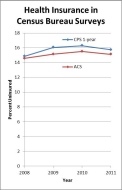
An official website of the United States government
Here’s how you know
Official websites use .gov
A .gov website belongs to an official government organization in the United States.
Secure .gov websites use HTTPS
A lock (
) or https:// means you’ve safely connected to the .gov website. Share sensitive information only on official, secure websites.
-
//
- Census.gov /
- Newsroom /
- Census Blogs /
- Random Samplings /
- How We Measure Health Insurance
How We Measure Health Insurance
How We Measure Health Insurance
Next week, the Census Bureau is releasing two sources for health insurance statistics in the United States: the Annual Social and Economic Supplement to the Current Population Survey (CPS ASEC) and the American Community Survey (ACS). While both surveys have questions that attempt to measure the same phenomena, they go about it in different ways.
Since 1987, the CPS ASEC has collected health insurance statistics every year, making it one of the most widely used sources of statistics on health insurance coverage in the United States. It provides statistics on health insurance status (insured or not insured), as well as type of coverage, for the whole nation, by demographic groups, and shows us trends over the last couple of decades. By combining two years of CPS sample, this survey can also provide state statistics on health insurance.
Starting five years ago, the Census Bureau also began asking about health insurance coverage using the ACS. With its much larger sample size, we can see health insurance statistics for a broader range of geographic levels including all 50 states, all counties, metro areas, and many other small geographies.
Both surveys obtain a person’s health insurance status by asking if a person has insurance through a number of different sources: an employer, directly through an insurance company, Medicare, Medicaid, Veterans Administration and other public sector insurance and the military. However, the surveys differ in both their time of collection and reference period.
Like the other topics in the CPS ASEC, which is conducted in February, March, and April, respondents answer questions about the previous calendar year. Specifically, we ask if they were covered at any time in the previous calendar year. CPS ASEC, thus, measures if a person was insured on any day during the previous year. They are considered “uninsured” only if, for the entire year, they had no coverage under any type of health insurance.
In contrast, the ACS is a rolling sample of households collected continuously all year long. We ask if a person is currently covered by any of the listed types of health insurance. So, ACS measures health insurance of the population based on whether people are insured at the point-in-time that they answered the survey during the year of collection.
There is also a variety of differences in the survey logistics. While the ACS is most often administered online or through a paper survey that is mailed to respondents, the CPS ASEC is administered by phone. Because of space limits within the paper survey, the ACS asks fewer and less detailed questions than the CPS ASEC. The ACS asks about the insurance coverage of each household member specifically, while the CPS ASEC asks if anyone in the household is covered, and if so, who that is.
With these variations and others, the CPS ASEC and ACS produce slightly different statistics on health insurance coverage. The two surveys show similar trends (as shown in the graph below), though the CPS ASEC shows higher uninsured rates for each year. This degree of consistency between the two surveys collected under such different conditions gives us confidence that these statistics are useful for those who need to understand the state of health insurance in America.
Many people contact us each year asking how to know which estimate to use for a particular purpose. For national statistics, we recommend the CPS because it provides a consistent historical time series at the national level back more than a decade. The CPS can also be used to look at limited state-level trends. However, because of the larger sample size and smaller sampling errors, we recommend using the ACS for subnational geographies.
Share
 Yes
Yes
 No
NoComments or suggestions?


Top

